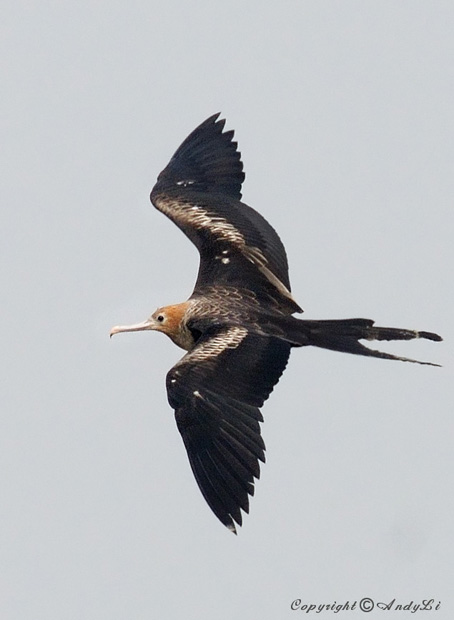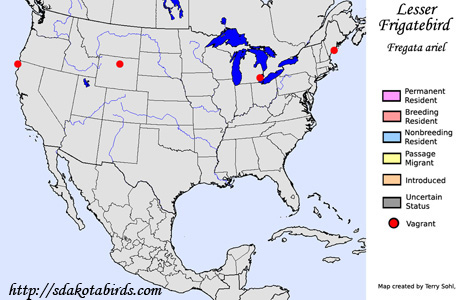| Length: 30 inches | Wingspan: 68 inches | Seasonality: Non-resident in South Dakota |
| ID Keys: Dark plumage overall, long deeply forked tail, females have white collar and breast, males white patch on underwing, juveniles have brownish head | ||
 The
Lesser Frigatebird is a small Frigatebird of the southern Hemisphere, where
they are primarily found in the warmer waters of the Indian and Pacific
Oceans. They are only extremely rare vagrants to North America, but
the sightings of the bird have been scattered and unusual. A sighting
in Michigan in 2011 was largely attributed to the effects of Hurricane
Katrina pushing the bird far inland. Another sighting was made off the
coast of Maine, unusual not only for the distance from the species' usual
range, but because of it's appearance over relatively cold waters.
However, the most unusual sighting of the species in North America was an
emaciated bird found in the dry habitat of Bighorn County in Wyoming in
2003. The female was still alive when found, but only lived for an
hour. At the time, it was thought to likely be a Magnificent
Frigatebird, given that species' occasional sightings far inland in the
United States. However,
analysis of photos of the bird after its death (and disposal) indicate the
bird was a very lost Lesser Frigatebird.
The
Lesser Frigatebird is a small Frigatebird of the southern Hemisphere, where
they are primarily found in the warmer waters of the Indian and Pacific
Oceans. They are only extremely rare vagrants to North America, but
the sightings of the bird have been scattered and unusual. A sighting
in Michigan in 2011 was largely attributed to the effects of Hurricane
Katrina pushing the bird far inland. Another sighting was made off the
coast of Maine, unusual not only for the distance from the species' usual
range, but because of it's appearance over relatively cold waters.
However, the most unusual sighting of the species in North America was an
emaciated bird found in the dry habitat of Bighorn County in Wyoming in
2003. The female was still alive when found, but only lived for an
hour. At the time, it was thought to likely be a Magnificent
Frigatebird, given that species' occasional sightings far inland in the
United States. However,
analysis of photos of the bird after its death (and disposal) indicate the
bird was a very lost Lesser Frigatebird.
Habitat: Found on a number of breeding colonies in the warmer waters of the Pacific and Indian Oceans, and a few areas off the coast of Brazil in the Atlantic Ocean. They typically nest on tropical islands with mangroves or bushes.
Diet: Feeds mostly on squid and fish, especially flying fish. They will also attempt to force other seabirds to disgorge their prey, catching it in mid-air. Also sometimes feeds on chicks of other seabirds, and will follow fishing vessels for scraps.
Behavior: Very clumsy on land and incapable of taking flight from the water, Frigatebirds spend most of their time in flight. Foraging is also done in flight, as they fly above the ocean's surface and drop down to grab prey in flight, when prey is spotted. As noted above, will also attempt to steal food from other seabirds.
Nesting: The Lesser Frigatebirds nests in small trees or shrubs, building a platform nest of sticks and branches. A single egg is laid, and both parents held to incubate it. Both parents tend to the young after hatching, a period that can last many months.
Song: The males have a variety of calls and a bill rattling during their courtship displays, where the red air sac is inflated as with other Frigatebird species.
Migration: Mature adults typically stay near breeding colonies even outside of the breeding season. However, juvenile birds and some non-breeding adults disperse widely across the tropical oceans.
Interactive eBird Map: Click here to access an interactive eBird map of Lesser Frigatebird sightings
Similar Species: Magnificent Frigatebird, Great Frigatebird
Conservation Status: The range of the Lesser Frigatebird remains very large, and despite indications of declining populations, they are still common in many areas. The IUCN lists the Lesser Frigatebird as a species of "Least Concern".
Further Information: 1) New Zealand Birds Online - Lesser Frigatebird
2) BirdLife International - Lesser Frigatebird
3) Cook Islands Biodiversity and Natural Heritage - Lesser Frigatebird
Photo Information: Photo taken by Andy Li - Photo licensed under Creative Commons Attribution NoDerivs 2.0 Generic License
| Click below for a higher-resolution map |
 |
| South Dakota Status: Non-resident in South Dakota |
Additional Lesser Frigatebird (coming soon!!)
